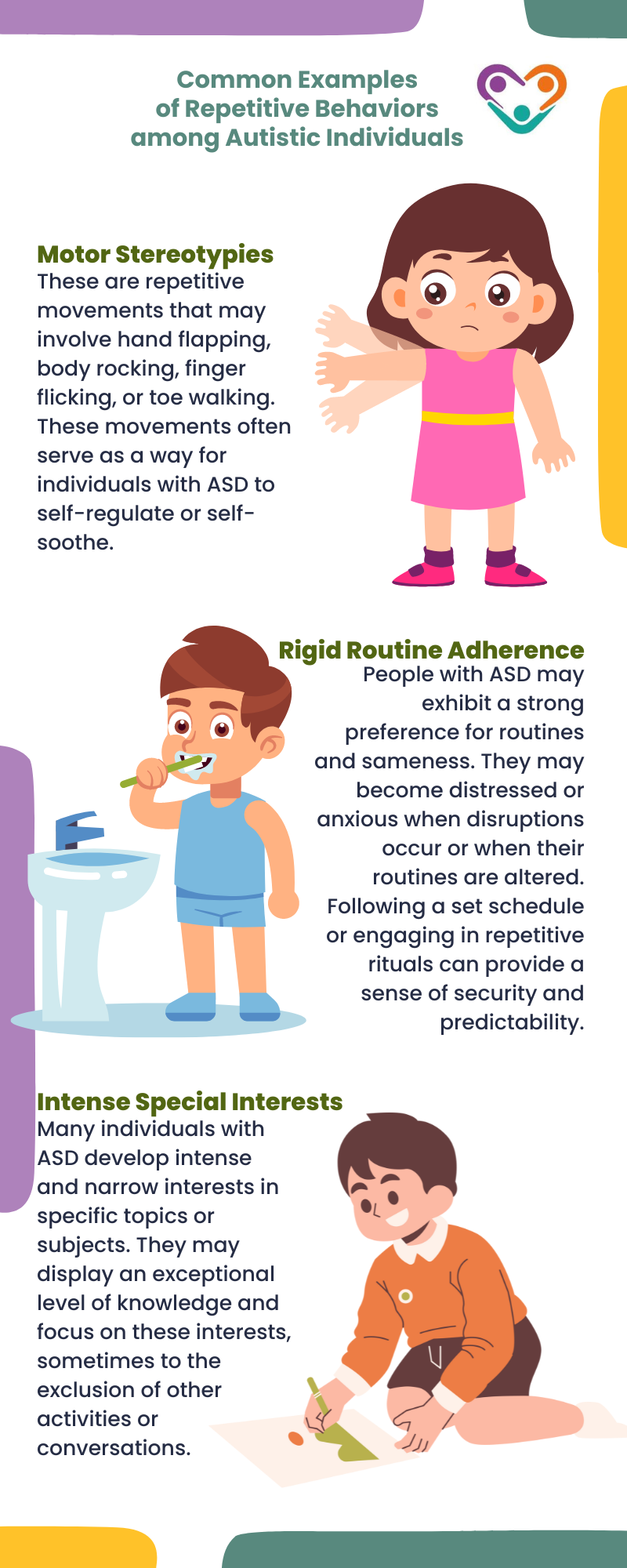Autism spectrum disorder (ASD) is a complex neurodevelopmental condition that affects individuals in various ways. The term “spectrum” is used because symptoms and characteristics of autism can range from mild to severe, and every individual with ASD is unique.
It’s worth noting that autism symptoms exist on a spectrum, which is why the condition is currently referred to as autism spectrum disorder (ASD). The symptoms can manifest differently in different individuals.
Some of the common symptoms seen across the spectrum include:
- Challenges with social interaction and communication
- Restricted, repetitive patterns of behavior, interests, or activities
- Sensory sensitivities or sensory processing difficulties
- Difficulties with verbal and nonverbal communication
- Challenges with understanding and expressing emotions
It’s important to note that the severity and combination of symptoms can vary widely among individuals with ASD. Some individuals may have difficulty with daily functioning and require significant support, while others may have fewer noticeable differences and be considered “high functioning.”
However, it is crucial to remember that even individuals with high-functioning autism can face challenges, including the experience of hiding or camouflaging their symptoms, which can lead to autistic burnout.

Communication Challenges
Communication challenges are a significant characteristic of autism spectrum disorder. Autistic individuals might struggle with both verbal and nonverbal communication.
Difficulties in nonverbal communication can make it challenging to understand and interpret facial expressions, body language, and other nonverbal cues during social interactions.
Verbal communication difficulties may include challenges with expressive language, receptive language, and pragmatic language skills. Some individuals with ASD may have difficulty adjusting their speech and behavior to match the context or mood of a conversation, making it harder to initiate or maintain relationships.
Understanding figures of speech and non-literal language, such as idioms or metaphors, can also be challenging for some individuals with autism.

Behavioral Patterns
There are certain behavioral patterns that are commonly observed among autistic individuals. These patterns can vary in severity and presentation from person to person.
Let’s look at two major behavioral patterns associated with ASD:
Repetitive Behaviors
Repetitive behaviors are a hallmark characteristic of autism. These behaviors can manifest in various ways and may serve different purposes for individuals with ASD. Some common examples of repetitive behaviors include:

It’s important to note that repetitive behaviors can vary in intensity and impact from person to person. While some individuals may exhibit more noticeable repetitive behaviors, others may engage in more subtle or internalized repetitive patterns.
Sensory Sensitivities
Sensory sensitivities are another common behavioral symptom of Autism Spectrum Disorder. Many individuals with ASD experience heightened or diminished sensitivity to certain stimuli in their environment. These sensitivities can affect any of the five senses: sight, sound, touch, taste, and smell.
Some examples include:
- Hypersensitivity – This refers to an increased sensitivity to sensory input. For instance, individuals with ASD may find certain sounds overwhelming or painful, have difficulty tolerating certain textures or clothing fabrics, or be highly sensitive to bright lights or strong smells.
- Hyposensitivity – On the other hand, hyposensitivity refers to a decreased sensitivity to sensory input. Individuals with ASD may seek out intense sensory stimulation, such as spinning, jumping, or seeking deep pressure, to satisfy their sensory needs.
It’s important to recognize and understand these sensory sensitivities as they can significantly impact an individual’s daily life and overall well-being. Accommodations and modifications can be made to create a more sensory-friendly environment and help individuals with ASD navigate their sensory experiences more comfortably.

Early Signs of Autism
Recognizing the early signs of autism spectrum disorder (ASD) is essential for early intervention and support. While every child is unique and may exhibit symptoms differently, there are some common indicators that can help identify potential signs of ASD.
These signs can be observed during infancy and toddlerhood.
Infancy Indicators
Some children show signs of autism spectrum disorder in early infancy. It’s important to note that these signs may vary from child to child. Here are some early indicators that may warrant further evaluation:
- Reduced eye contact
- Lack of response to their name
- Indifference to caregivers
These signs are usually seen by the age of 2 years. If parents or caregivers notice any of these indicators, it is recommended to consult with a pediatrician or healthcare professional for a thorough assessment.
Toddler Behavior Cues
Signs of autism spectrum disorder often appear early in development, with obvious delays in language skills and social interactions typically before the age of 2 years. In some cases, there may be a regression in language skills and social interactions between the ages of 15 and 24 months.
This regression involves a sudden or gradual loss of language abilities and increased social withdrawal, which can be significant signs of ASD in toddlers.
Additionally, children on the autism spectrum may exhibit differences in using and understanding gestures, such as pointing. While most children typically point to objects they want by 12 months, a child with ASD might lead a parent to the object without making eye contact or even place the parent’s hand on the object itself.
These differences in gesture usage can be early signs of autism spectrum disorder in young children.
Early screening for autism spectrum disorder is crucial if parents have concerns about their child’s social, language, or developmental skills. Acting early and consulting with a pediatrician can significantly impact a child’s development, making a difference in providing appropriate support and interventions for children with ASD.

Diagnosis and Severity Levels
Healthcare professionals rely on specific diagnostic criteria to assess an individual’s symptoms and behaviors. Additionally, the severity level of ASD can vary, ranging from low functioning to high functioning.
Let’s explore the diagnostic criteria and the functioning spectrum associated with ASD.
Diagnostic Criteria
The Diagnostic and Statistical Manual of Mental Disorders, 5th edition, text revision (DSM-5-TR) provides a set of diagnostic criteria that help identify individuals with ASD. These criteria focus on two main categories: communication patterns and behavioral patterns.
These patterns may involve verbal or spoken communication, nonverbal communication like facial expressions and body language, as well as limited and repetitive behaviors.
To receive a diagnosis of ASD, an individual must exhibit symptoms from both categories consistently and across different settings. The severity of these symptoms can vary widely, hence the need for a comprehensive evaluation by a healthcare professional experienced in diagnosing ASD.
Functioning Spectrum
Each individual with ASD has a unique pattern of behavior and level of severity. The functioning spectrum refers to the range of abilities and challenges experienced by individuals with ASD.
It takes into account various factors such as intellectual functioning, language skills, and social interactions.
Some children with ASD may have difficulties in learning and display signs of lower-than-normal intelligence. On the other hand, some individuals with ASD may exhibit normal to high intelligence but struggle with communication and social situations.
The functioning spectrum recognizes the diverse range of abilities and challenges present within the autism community.
To better understand the functioning spectrum, it is often classified into three levels:
- Level 1: Requiring Support – Individuals at this level require some support to navigate social situations and daily life. They may have difficulties initiating and sustaining conversations, as well as challenges with social interactions and flexibility in their behavior.
- Level 2: Requiring Substantial Support – Individuals at this level require more substantial support to function in social, communication, and behavioral domains. They may exhibit marked difficulties in initiating conversations, responding to others, and dealing with changes in routine or environment.
- Level 3: Requiring Very Substantial Support – Individuals at this level require very substantial support in multiple areas, including communication, social interactions, and behavioral functioning. They may have severe impairments in verbal and nonverbal communication, limited interests, and repetitive behaviors.
It is important to note that the functioning level may change throughout an individual’s life as they receive interventions, therapies, and support. The goal is to help individuals with ASD reach their full potential and improve their overall quality of life.
By identifying and addressing ASD symptoms early, parents and caregivers can play a vital role in their child’s development. Early intervention provides the necessary support and resources to help children with ASD reach their full potential and thrive in various aspects of their lives.
Remember, if you have concerns about your child’s social, language, or developmental skills, it is essential to consult with a healthcare professional or pediatrician. They can guide you through the process of screening and evaluation, leading to early identification and access to appropriate interventions for children with autism spectrum disorder.
If you’re seeking specialized ABA therapy in New Jersey, Indiana, Georgia, and New York, Golden Care offers comprehensive services tailored to meet the unique needs of each individual. Contact us to learn more or book a consultation today.
Sources:
https://www.cdc.gov/autism/signs-symptoms/index.html
https://www.mayoclinic.org/diseases-conditions/autism-spectrum-disorder/symptoms-causes/syc-20352928
https://psychcentral.com/autism/autism-spectrum-disorder-symptoms



